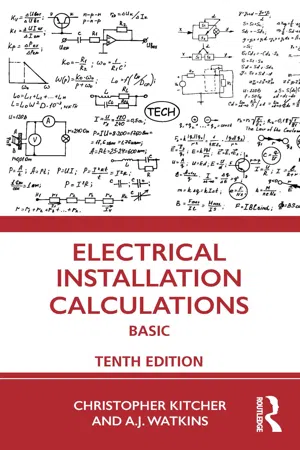
- 208 pages
- English
- ePUB (mobile friendly)
- Available on iOS & Android
About this book
Now in its 10th edition, Electrical Installation Calculations: Basic has been updated to include any changes required to bring it in line with the 18th edition of the IET electrical wiring regulations (BS7671:2018).
Electrical calculations required for exams can prove difficult to master, but for more than 40 years, this book series has proved very helpful to students and professional electrical engineers studying for electrical qualifications. It covers all the calculations required for Level 2 electrical qualifications, along with other useful calculations that may be used in the electrical industry but may not feature in the syllabus of some exams.
Although the calculations in this book are referred to as 'basic', they form the foundation of all calculations carried out in the electrical industry, which have been set out simply with worked examples along with additional questions and answers. Key terms are explained in a glossary, which can be used to assist with the reader's understanding.
Frequently asked questions
- Essential is ideal for learners and professionals who enjoy exploring a wide range of subjects. Access the Essential Library with 800,000+ trusted titles and best-sellers across business, personal growth, and the humanities. Includes unlimited reading time and Standard Read Aloud voice.
- Complete: Perfect for advanced learners and researchers needing full, unrestricted access. Unlock 1.4M+ books across hundreds of subjects, including academic and specialized titles. The Complete Plan also includes advanced features like Premium Read Aloud and Research Assistant.
Please note we cannot support devices running on iOS 13 and Android 7 or earlier. Learn more about using the app.
Information
1 Use of Calculators
2 Simple Transposition of Formulae
- ■ The subject must be on the top line and must be on its own.
- ■ The answer will always be on the top line.
- ■ To get the subject on its own values must be moved.
- ■ Any value that moves across the = sign must move from above the line to below line or from below the line to above the line.
Table of contents
- Cover
- Half Title
- Title Page
- Copyright Page
- Table of Contents
- Preface
- 1 Use of Calculators
- 2 Simple Transposition of Formulae
- 3 SI Units
- 4 Conductor Colour Identification
- 5 Circuit Calculations
- 6 Voltage Drop
- 7 Areas, Perimeters and Volume
- 8 Space Factors
- 9 Coulombs and Current Flow
- 10 Internal Resistance
- 11 Power in a d.c. and Purely Resistive a.c. Circuit
- 12 Power Factor
- 13 Transformers
- 14 Electromagnetic Effect
- 15 Induced e.m.f.
- 16 Self-Inductance
- 17 Mutual Inductance
- 18 Cable Selection
- 19 Earth Fault Loop Impedance
- 20 Material Costs, Discounts and Value Added Tax
- 21 Electrostatics
- 22 Formulae
- 23 Electronic Symbols
- 24 Glossary
- 25 Answers to Exercises
- 26 Additional Questions and Answers